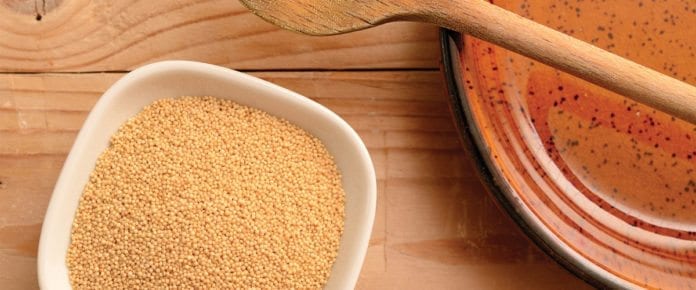[dropcap size=big]F[/dropcap]ind out how aji amarillo, turmeric, Thai basil and amaranth are contributing to Canada’s increasingly popular South-American and Asian culinary scene
By Mary Luz Mejia
Aji Amarillo
Aji amarillo is the most popular chili used in Peruvian cuisine. In fact, the yellow chili, as it translates from Spanish, has been named the most important ingredient in Peruvian cooking by Gastón Acurio, the South American country’s superstar chef. The chilies are originally green but eventually mature to a warm orange-yellow hue. Used in dishes such as Papas a la Huancaina (a popular boiled potato dish smothered in chili sauce), the spicy ingredient is prized for its bright, citrusy flavour and medium to hot heat. When dried, the name changes to aji mirasol. The chili can also be found frozen, as a powder or in a paste form at most Latin grocers or specialty food shops.
Amaranth
South American amaranth is the seed of the amaranth plant, although today it’s often called a grain. It’s a nutritional powerhouse that’s a good source of iron, dietary fibre and calcium, boasting more protein than quinoa (in fact it’s a complete protein). It can be prepared as a porridge-like cereal, sprouted, toasted to play up its inherent nutty flavour or even popped like popcorn. Amaranth makes a tasty side dish and is becoming better known as a viable gluten-free menu item.
Turmeric
Turmeric, often dubbed “Indian saffron,” is derived from the root of the Curcuma long plant. It has a deep orange flesh that gives everything it touches, from curries to ballpark mustards, a signature golden hue. The warming spice, which tastes slightly peppery with a bitter undertone, is often used in Chinese and Indian medicine as a potent anti-inflammatory and antioxidant due to naturally existing properties called curcumin. Apart from being a spice, and a healing herb, turmeric’s pigment has also made it a popular textile dye.
Thai Basil
Thai Basil, or “Sweet Thai,” is a member of the mint family (Oscimum basilicum). It’s used throughout Thailand, Vietnam, Cambodia and Laos where it’s prized for its green, fresh fragrance and its sweet, anise and clove-like flavour. Unlike sweet basil, Thai basil has distinctive purple stems and leaves. It’s usually used as a finishing herb, torn or chopped and sprinkled into a dish as a final ingredient. The herb lends a clean, green note to a host of dishes, from noodles and soups to fish-based meals.


















